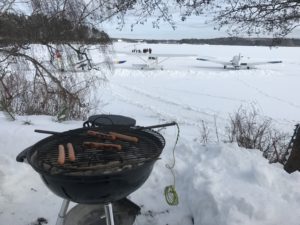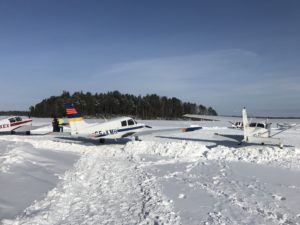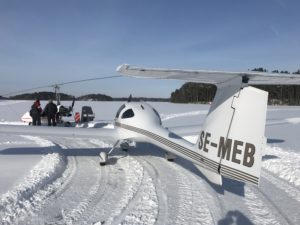
Racing tracks on the left and runway on the right
For the last two winters, LFK members have had the opportunity to land on the ice at Kögenes on Lake Stora Rängen thanks to the efforts of Tore Mårdh who has checked the ice thickness and marked out a runway for us. In Östergötland we don’t always get sufficiently cold winters to give us the 25-30 cm of ice we require to land on local lakes. To get reliable ice every year you need to go further north.
For many years, the Ice Fly-In on Lake Siljän at Rättvik in Dalarna was one of Sweden’s largest fly-ins. Our group owned Jodel ”Echo-Delta” has made the trip from ESSL to Rättvik’s ice many times. Last time I flew Echo-Delta there was in March 2013 and there was around 85 aircraft present from Sweden, Norway and Åland. Unfortunately, 2013 was the last year for the fly in, due to the difficulty in finding volunteers who could help set up the event. Snow would usually have to be cleared to create the runway, taxiways and aircraft parking areas. In 2013, they estimated that they cleared snow off an area of 42,000 m2!
Recently a new ice fly in event has been publicised – Speed Weekend (it is publicised by the organisers in English as Speed Weekend, see www.landracing.se/event/speed-weekend-2017). This is primarily a car and motorcycle ice racing / speed record event but as they have all the machinery and people available to build multiple racetracks then it is a relatively easy job to plough a runway, taxiways and an aircraft parking area. Speed Weekend 2017 was based on Storsjön by the village of Årsunda just south of Sandviken. The flying part of the event was organised by Västra Gästrike Flygklubb (www.flygklubbenstorvik.se). This year the ice on Storsjön was 43 cm thick.
At 09:20 on the 25th February, Echo-Delta departed ESSL heading north towards the Speed Weekend fly in. It was certainly a weekend but there was not much speed in Echo-Delta. A consistent headwind dropped our ground speed to around 75 knots. Luckily, it was a fantastic sunny day and Lars and I had a good time checking out various interesting places along the way. In just under two hours, we had Storsjön in sight. The published information included the coordinates, runway 18–36, 800 meters long and Radio Storvik Sjö 123.55. We had no diagram as to exactly where the runway was in relation to the ice racing tracks or other features. We called up on the radio with 5 minutes to run and informed them at we would overfly the lake at 2000 feet in order to identify the runway and then join the circuit. Although it was only an air to ground service we did hear that several aircraft were ”cleared to land 36”, instead of ”runway 36, land at your discretion”.
As we got nearer, we could see parked aircraft and the runway. We joined the circuit overhead and came in number two to an aircraft on base leg for runway 36. We had to keep plenty of height on final to clear the tall pine trees by the shore, once clear it was engine to idle to lose the height and set the aircraft after the threshold. It is advisable to land a little bit long at such an ice fly in as there can be snow before the threshold and you never can be certain that there are not people, dogs and other hazards in the undershoot. With the wheels on the runway, I could feel the aircraft slipping ever so slightly on the ice. Using the rudder carefully to maintain direction and without using brakes we maintained the centreline and exited the runway via the taxiway at the end. The taxiway had a lot of windblown snow on it so taxiing required a fair amount of engine rpm to keep rolling. We were marshalled to a parking place, and after shutting down, we received a ”goody bag” containing a hat, lanyard, pen and other items courtesy of the event sponsor.

Echo Delta parked on Sjorsjön, Årsunda
We decided to check out the flight line, which contained a mix of normal-class and X-class aircraft, including SE-MEB from LFK. There were around 40 visiting aircraft and Västra Gästrike Flygklubb’s diesel Cadet was busy the whole day with introduction flights for visitors to the event. A short walk away was the ice racing tracks that included a 4 km long drag racing track for record attempts. There was going to be an attempt at the world record on ice by the custom built Arctic Arrow with a goal of 400 km/h. The Arctic Arrow looks like a drag racer on skates with power coming from a jet/rocket type engine. They had achieved 320 km/h on the Friday, but we did not see (or hear) the Arctic Arrow in action on Saturday. There were several thousand spectators and several hundred competition cars and motorcycles so this is quite a big event. One vehicle of interest for pilots was the Propster electric powered ice yacht. The composite construction and the electric driven pusher prop reminding us of a Bede BD-5 aircraft without wings.

With wings maybe this could fly!
The facilities of Årsunda Camping were available but there were long queues for both the restaurant and the toilets. The flying club were grilling hamburgers out by the runway and there was no queue at all. After we had surveyed the various cars and motorcycles and soaked up the atmosphere of Speed Weekend, we headed home in Echo Delta. With a front coming in from the west, the wind had veered from north west to south west so it was a headwind on the way home. As always, when travelling north in the winter, you have to assume that most of the flying club airfields will be closed due to snow, therefore fuel planning and diversionary airfields need careful planning. With the ice so thick, most lakes could be used as a runway in an emergency and Västerås/Hässlö was our potential fuel stop. However, with careful mixture leaning, we had enough fuel for the round trip with sufficient fuel reserve. It was a two-hour flight before we landed back at ESSL, overtaken on the way by SE-MEB with her 20-30 knot cruise advantage over us.
Speed Weekend is certainly an interesting destination and is a well-organised fly in. Look out for the event in 2018, which we assume will be same time and same place.
Peter Curwen
 De senaste veckorna har varit kalla och det har kommit massor av snö. De flesta sitter inne och värmer upp sig framför en brasa, men för skidåkare och för oss piloter så innebär det chans för att testa på lite vintersport. I vårt fall att landa med flygplan på frusna sjöar.
De senaste veckorna har varit kalla och det har kommit massor av snö. De flesta sitter inne och värmer upp sig framför en brasa, men för skidåkare och för oss piloter så innebär det chans för att testa på lite vintersport. I vårt fall att landa med flygplan på frusna sjöar. Denna helg så har det därför anordnats en Is Fly-In på Stora Rängen. LFK fixade fram grillkorv och Tore ställde upp och bjöd på kaffe för de som hälsade på.
Denna helg så har det därför anordnats en Is Fly-In på Stora Rängen. LFK fixade fram grillkorv och Tore ställde upp och bjöd på kaffe för de som hälsade på. Stort tack till Tore med hjälpredor som anordat en bra landningsbana och gjort det möjligt för klubbmedlemmarna att prova på något lite annorlunda. Klubbens instruktörer har dessutom passat på att träna islandning med sina elever.
Stort tack till Tore med hjälpredor som anordat en bra landningsbana och gjort det möjligt för klubbmedlemmarna att prova på något lite annorlunda. Klubbens instruktörer har dessutom passat på att träna islandning med sina elever.



